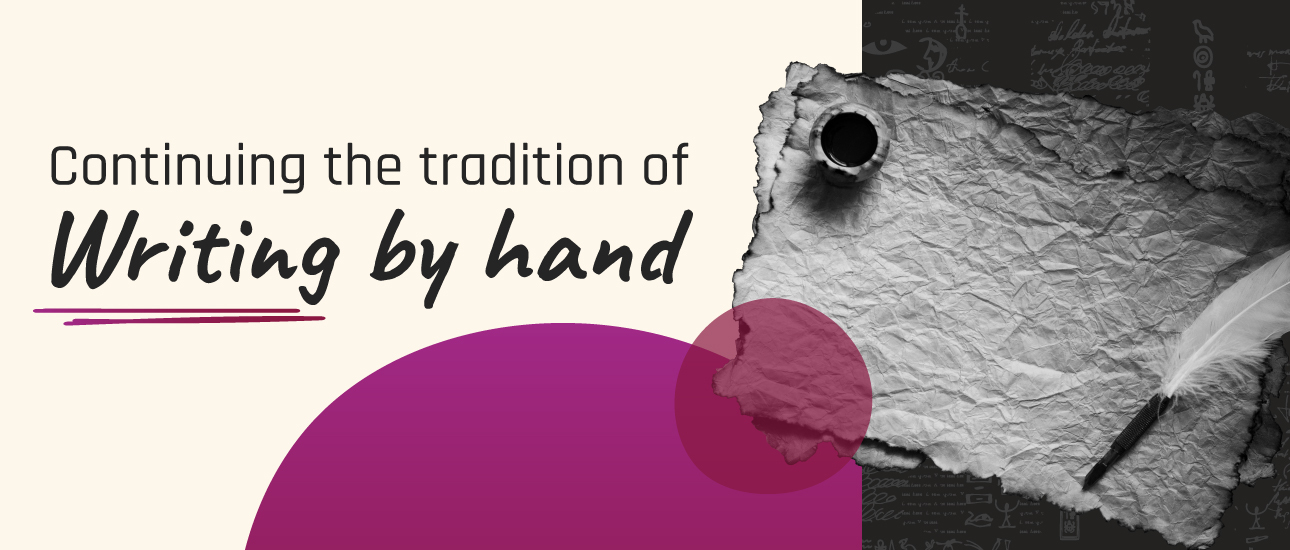LMExams

Early humans communicated with each other verbally. Verbal communication was primarily used to pass on cultural norms, rituals, and stories from one generation to the other. As cultures evolved and changed, the need for communication changed too. Simple drawings became pictographs which were then standardized in each culture. This evolved into written language. And over time, this led to evolution of handwriting.
Origin of handwriting
Writing was a codified system of standard symbols. The repetition of simple, agreed upon shapes to represent ideas was used. The first recognizable writing systems developed within 1,200 years of each other in three major cultures. In 3000 BC, Mesopotamian cuneiform developed. In 2800 BC, Egyptian hieroglyphs developed and in 1800 BC, the precursor to Chinese kanji was developed. The development of handwriting helped cultures document and record events, history, laws, develop and express theories in math, science and medicine, and helped create literature. Pictographs were used to represent people, places and things. Soon many pictographs were combined to represent ideas and knowledge was required to interpret the new symbols. These became ideographs which were abstract symbols that evolved beyond the original drawings.
Evolution of handwriting
Sumerian scribes used cuneiform writing using a reed stylus to make wedge-shaped indentations on clay tablets. Cuneiform means “wedge-shaped”. Ideographs were combined to sound longer words which later developed into phonograms.
Following the Mesopotamian cuneiforms, Egyptians started writing various forms of handwriting with the help of papyrus and reed brushes. Ink flowed freely on the papyrus and this made their writing smooth and hassle-free. Hieroglyphs were simplified around 1500 BC, and became known as hieratic script (priestly writing). This was used almost exclusively for religious writing, but was later used for commerce. Post this, around 1500 BC, the ancient Phoenician alphabet was developed. It has 22 phonetics-based symbols. By 800 BC, it had spread to Greece and under Alexander the Great, it further spread to parts of Egypt, Persia, and India.
The Roman empire had conquered Greece by 146 BC and adapted the 23-letter alphabet. By 400 AD, Romans used the Roman script for transactions, book-keeping and correspondence. Letters began to flow together to save time and space on parchment paper. Thus, the earliest lower case letters evolved from the capitals.
Christianity was a widely popular religion and hand-written Bibles were in circulation. The lettering used in them were called the Celtic style of lettering. In 700 AD, the ruler Charlemagne controlled most of Europe, and appointed an English monk to oversee standardized lettering practices for copying texts. Thus, lettering styles continued to develop.
Gutenberg created his movable type press in the mid-1400s, he modelled his letters based on the style of the scribes at the time. The development of copperplate engraving allowed for the use of very delicate typefaces, which greatly influenced handwriting. Handwriting masters began to grow in number, and produce beautifully written documents. Elegant handwriting became a sign of social status.
By the 1700s, many special schools taught handwriting techniques which was called penmanship. Master penmen with beautiful handwriting were employed to copy official documents such as land deeds, birth and death certificates, and legal documents. In the 1800s, Charles Zaner and Elmer Bloser founded the Zaner-Bloser company and created materials that could be used to teach good penmanship. Later in 1970s, Donals Neal Thurber developed slanted letters which evolved into cursive writing. It is also called the D’Nealian style of writing.
Conclusion
In today’s world, thanks to the internet, typing, texting, email, and online documents are more common that handwriting. However, handwriting will always have its special place even in the modern world. A hand-written note is always more valuable and conveys emotion and meaning more effectively. Even as technology evolves and there are many new ways to communicate, share ideas and work, ultimately, they all originate from handwritten sources like books, documents and letters. LMExams continues to promote beautiful handwriting by encouraging students to use their exam-only tablet computing device DigiTaal and their paperless exam platform to continue the tradition of writing by hand.
Reference Links
https://www.vletter.com/help/font-faq/history-of-handwriting.html
https://callistyle.in/blog/history-of-handwriting/
https://www.ignitepost.com/blog/a-brief-history-of-handwriting